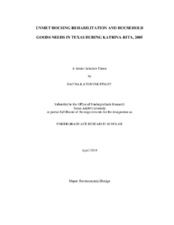| dc.description.abstract | The U.S. was appalled by the overall devastation of Hurricane Katrina, the costliest storm in American history. Just days later the Gulf Coast was swept by Hurricane Rita which amplified the already disastrous situation. In light of these concurrent disasters Texas communities responded to host millions of evacuees. The state?s Emergency Management Office designated 2-1-1 as the communication hub between evacuees searching for non-emergency help and agencies and programs providing resources. Staff and volunteers provided information and referrals to available, affordable services while simultaneously logging the caller?s location and unmet needs.
The purpose of this study is to examine unmet housing needs that occurred prior to, during, and following the 2005 Katrina and Rita hurricane disasters using Texas 2-1-1 caller data from August 1 through December 31, 2005. Following the 2005 Katrina and Rita hurricane disasters, the Texas 2-1-1 lines were flooded with calls for help. Amid the myriad of requests were a multitude of appeals for aid in the housing sector. Conclusions and recommendations will be communicated to the 2-1-1 organizations nationally, and to organizations and professionals dealing with disaster management and services for the built environment.
Analysis of Texas 2-1-1 data will enable identification of unmet needs captured in ?real time? during fall 2005 regarding date, location, and types of unmet needs logged by the network of 2-1-1 programs throughout Texas. The findings will result in a better understanding of disaster preparations, management and response for future disasters. Understanding unmet housing needs during disaster situations will have wide implications for the field of architecture including reducing costs for planning and design in disaster-prone areas. The unfortunate, yet unique, events of the 2005 hurricane season provide an opportunity to examine unmet housing needs prior to, during, and following this variety of disaster. Specifically, renovation and remodeling needs requested by 2-1-1 callers in Texas will be investigated for differences by disaster phase and location. Further examination will be done to identify differences in these types of needs by population size, demographics, and economics. | en |


